Project Management Techniques: Payback, NPV, IRR, Crashing, Restructuring, and Respecifying
VerifiedAdded on 2023/06/18
|10
|1772
|333
AI Summary
This article discusses various project management techniques such as Payback, NPV, IRR, Crashing, Restructuring, and Respecifying. It explains their advantages and disadvantages and provides insights into how to apply them in real-life scenarios. The article also includes an illustration of how to calculate payback period, NPV, and IRR.
Contribute Materials
Your contribution can guide someone’s learning journey. Share your
documents today.

PROJECT
MANAGEMENT
MANAGEMENT
Secure Best Marks with AI Grader
Need help grading? Try our AI Grader for instant feedback on your assignments.
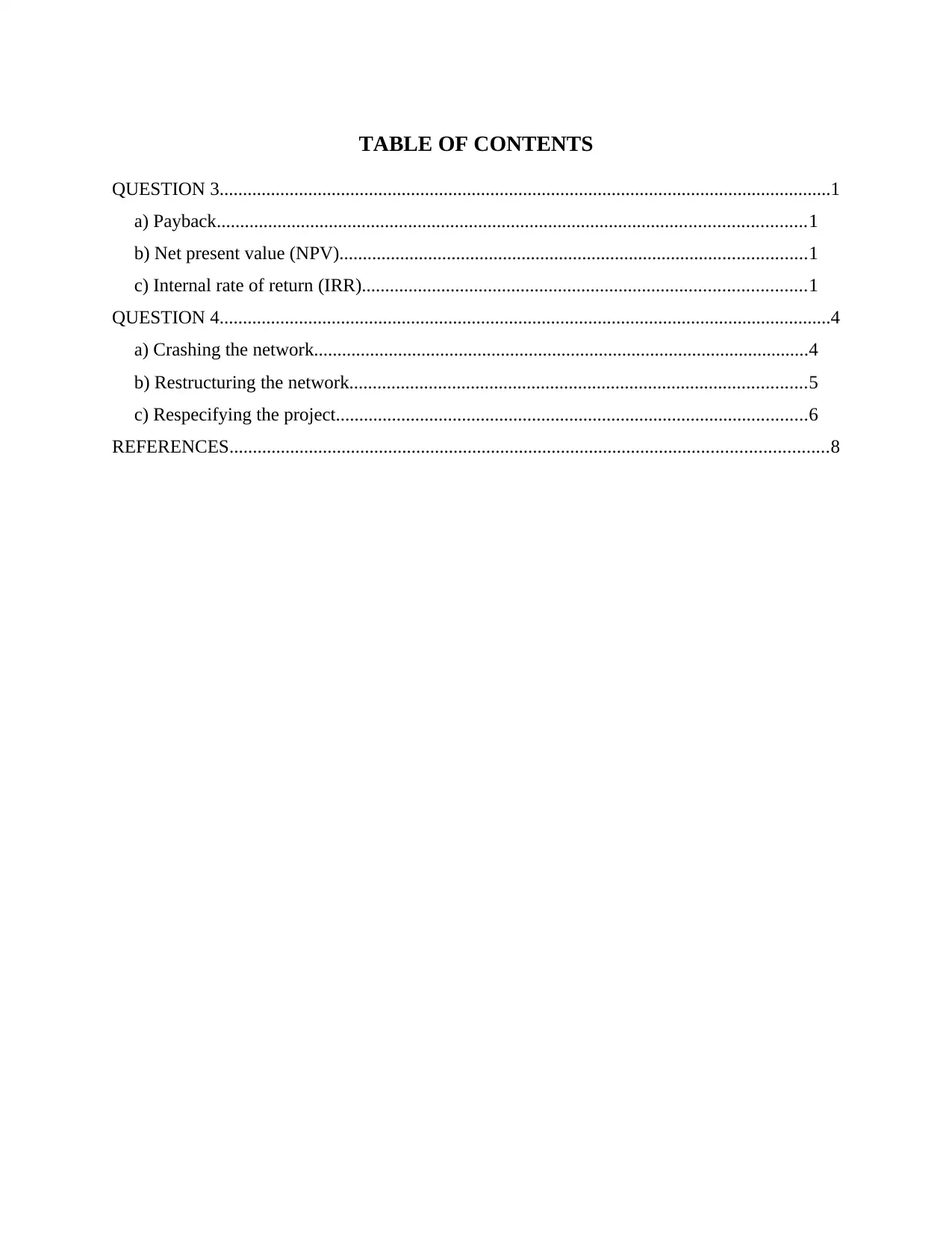
TABLE OF CONTENTS
QUESTION 3...................................................................................................................................1
a) Payback..............................................................................................................................1
b) Net present value (NPV)....................................................................................................1
c) Internal rate of return (IRR)...............................................................................................1
QUESTION 4...................................................................................................................................4
a) Crashing the network..........................................................................................................4
b) Restructuring the network..................................................................................................5
c) Respecifying the project.....................................................................................................6
REFERENCES................................................................................................................................8
QUESTION 3...................................................................................................................................1
a) Payback..............................................................................................................................1
b) Net present value (NPV)....................................................................................................1
c) Internal rate of return (IRR)...............................................................................................1
QUESTION 4...................................................................................................................................4
a) Crashing the network..........................................................................................................4
b) Restructuring the network..................................................................................................5
c) Respecifying the project.....................................................................................................6
REFERENCES................................................................................................................................8
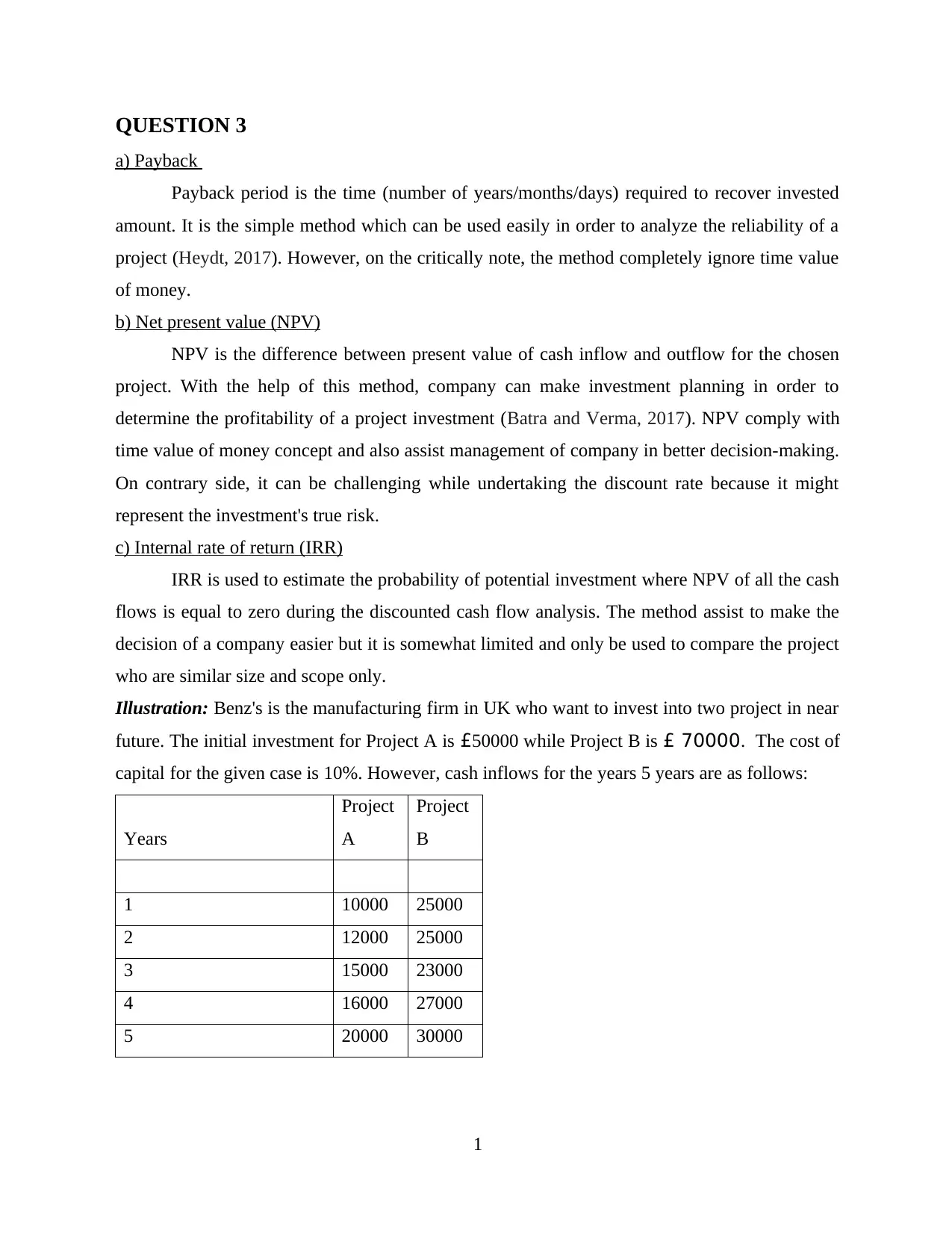
QUESTION 3
a) Payback
Payback period is the time (number of years/months/days) required to recover invested
amount. It is the simple method which can be used easily in order to analyze the reliability of a
project (Heydt, 2017). However, on the critically note, the method completely ignore time value
of money.
b) Net present value (NPV)
NPV is the difference between present value of cash inflow and outflow for the chosen
project. With the help of this method, company can make investment planning in order to
determine the profitability of a project investment (Batra and Verma, 2017). NPV comply with
time value of money concept and also assist management of company in better decision-making.
On contrary side, it can be challenging while undertaking the discount rate because it might
represent the investment's true risk.
c) Internal rate of return (IRR)
IRR is used to estimate the probability of potential investment where NPV of all the cash
flows is equal to zero during the discounted cash flow analysis. The method assist to make the
decision of a company easier but it is somewhat limited and only be used to compare the project
who are similar size and scope only.
Illustration: Benz's is the manufacturing firm in UK who want to invest into two project in near
future. The initial investment for Project A is £50000 while Project B is £ 70000. The cost of
capital for the given case is 10%. However, cash inflows for the years 5 years are as follows:
Years
Project
A
Project
B
1 10000 25000
2 12000 25000
3 15000 23000
4 16000 27000
5 20000 30000
1
a) Payback
Payback period is the time (number of years/months/days) required to recover invested
amount. It is the simple method which can be used easily in order to analyze the reliability of a
project (Heydt, 2017). However, on the critically note, the method completely ignore time value
of money.
b) Net present value (NPV)
NPV is the difference between present value of cash inflow and outflow for the chosen
project. With the help of this method, company can make investment planning in order to
determine the profitability of a project investment (Batra and Verma, 2017). NPV comply with
time value of money concept and also assist management of company in better decision-making.
On contrary side, it can be challenging while undertaking the discount rate because it might
represent the investment's true risk.
c) Internal rate of return (IRR)
IRR is used to estimate the probability of potential investment where NPV of all the cash
flows is equal to zero during the discounted cash flow analysis. The method assist to make the
decision of a company easier but it is somewhat limited and only be used to compare the project
who are similar size and scope only.
Illustration: Benz's is the manufacturing firm in UK who want to invest into two project in near
future. The initial investment for Project A is £50000 while Project B is £ 70000. The cost of
capital for the given case is 10%. However, cash inflows for the years 5 years are as follows:
Years
Project
A
Project
B
1 10000 25000
2 12000 25000
3 15000 23000
4 16000 27000
5 20000 30000
1
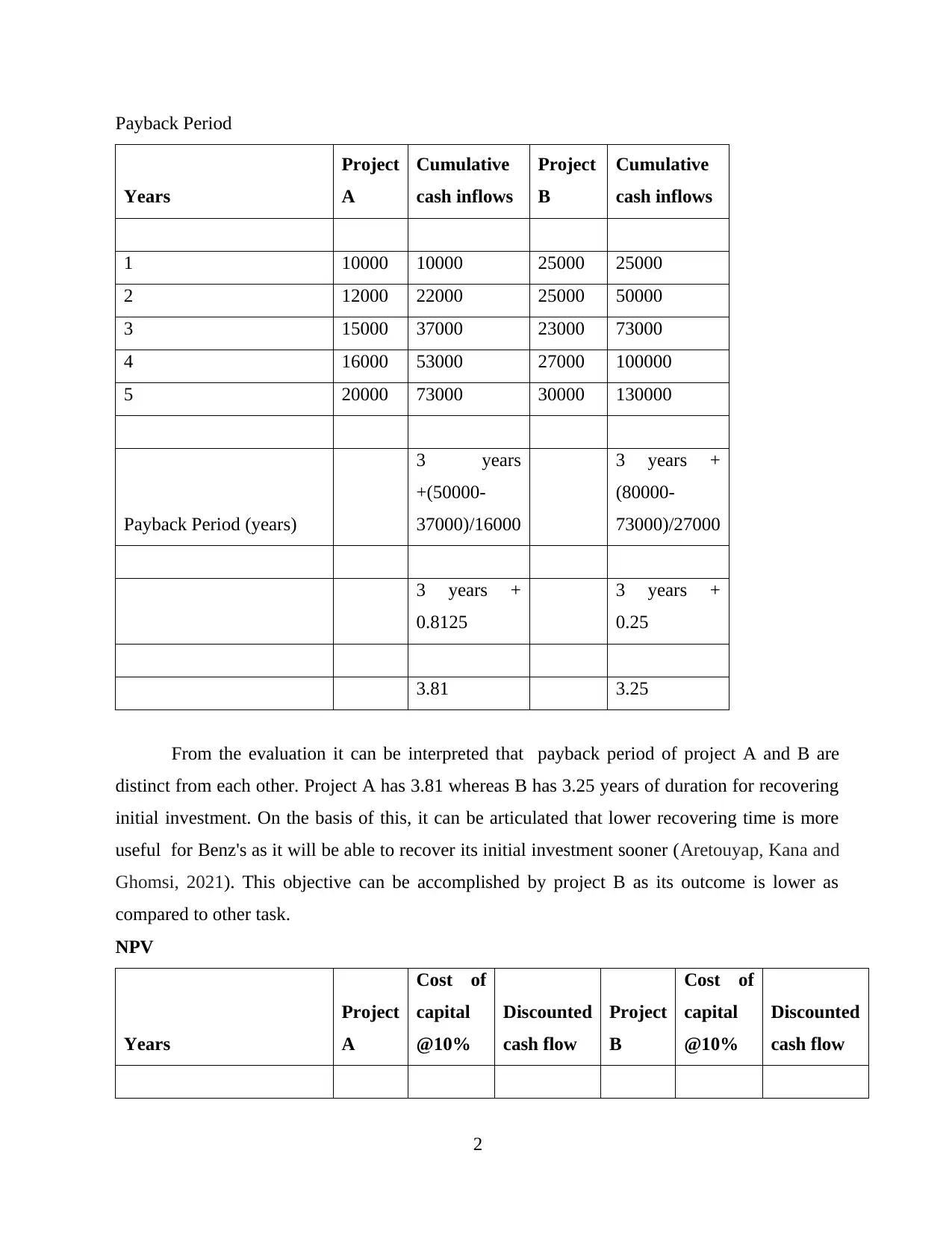
Payback Period
Years
Project
A
Cumulative
cash inflows
Project
B
Cumulative
cash inflows
1 10000 10000 25000 25000
2 12000 22000 25000 50000
3 15000 37000 23000 73000
4 16000 53000 27000 100000
5 20000 73000 30000 130000
Payback Period (years)
3 years
+(50000-
37000)/16000
3 years +
(80000-
73000)/27000
3 years +
0.8125
3 years +
0.25
3.81 3.25
From the evaluation it can be interpreted that payback period of project A and B are
distinct from each other. Project A has 3.81 whereas B has 3.25 years of duration for recovering
initial investment. On the basis of this, it can be articulated that lower recovering time is more
useful for Benz's as it will be able to recover its initial investment sooner (Aretouyap, Kana and
Ghomsi, 2021). This objective can be accomplished by project B as its outcome is lower as
compared to other task.
NPV
Years
Project
A
Cost of
capital
@10%
Discounted
cash flow
Project
B
Cost of
capital
@10%
Discounted
cash flow
2
Years
Project
A
Cumulative
cash inflows
Project
B
Cumulative
cash inflows
1 10000 10000 25000 25000
2 12000 22000 25000 50000
3 15000 37000 23000 73000
4 16000 53000 27000 100000
5 20000 73000 30000 130000
Payback Period (years)
3 years
+(50000-
37000)/16000
3 years +
(80000-
73000)/27000
3 years +
0.8125
3 years +
0.25
3.81 3.25
From the evaluation it can be interpreted that payback period of project A and B are
distinct from each other. Project A has 3.81 whereas B has 3.25 years of duration for recovering
initial investment. On the basis of this, it can be articulated that lower recovering time is more
useful for Benz's as it will be able to recover its initial investment sooner (Aretouyap, Kana and
Ghomsi, 2021). This objective can be accomplished by project B as its outcome is lower as
compared to other task.
NPV
Years
Project
A
Cost of
capital
@10%
Discounted
cash flow
Project
B
Cost of
capital
@10%
Discounted
cash flow
2
Secure Best Marks with AI Grader
Need help grading? Try our AI Grader for instant feedback on your assignments.
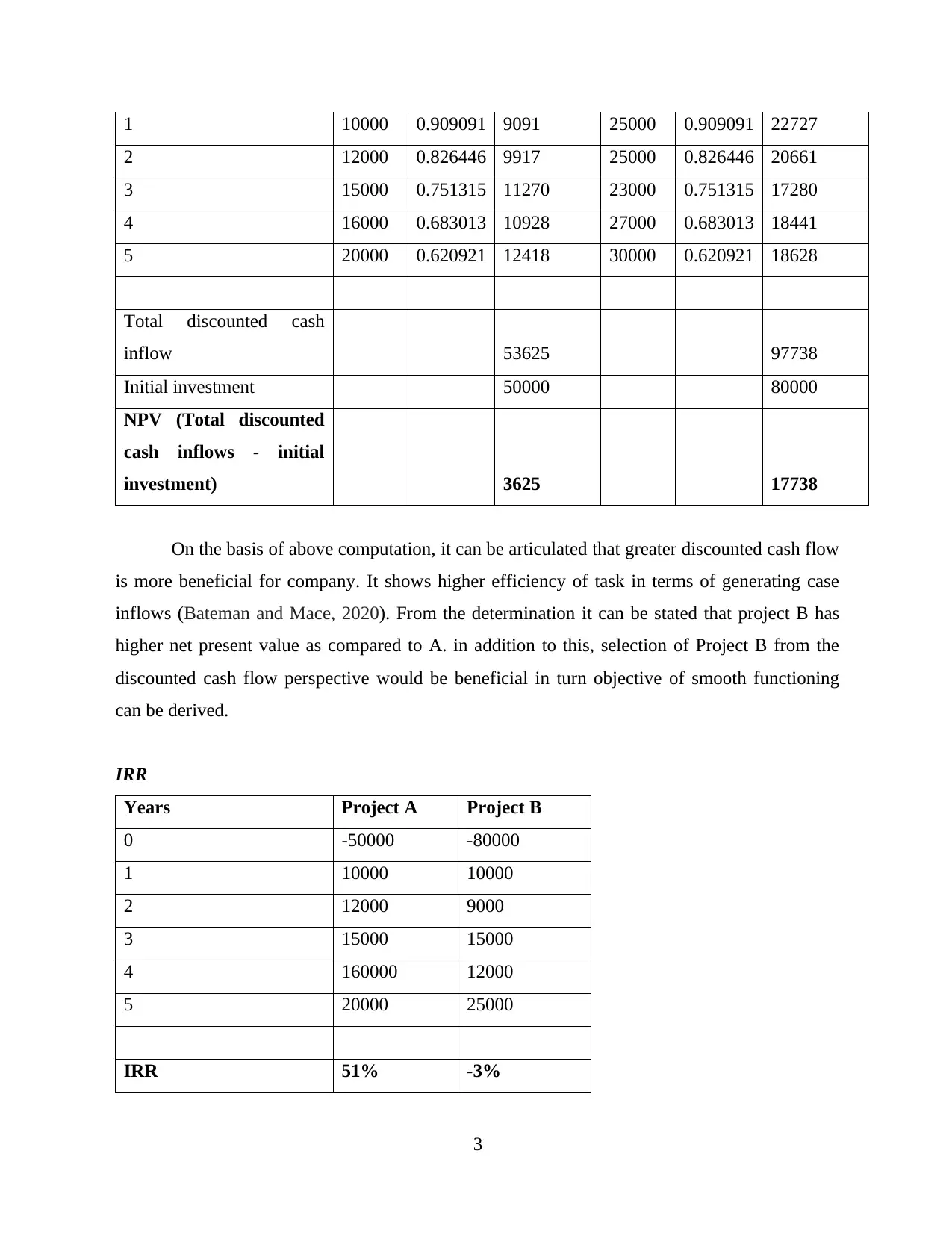
1 10000 0.909091 9091 25000 0.909091 22727
2 12000 0.826446 9917 25000 0.826446 20661
3 15000 0.751315 11270 23000 0.751315 17280
4 16000 0.683013 10928 27000 0.683013 18441
5 20000 0.620921 12418 30000 0.620921 18628
Total discounted cash
inflow 53625 97738
Initial investment 50000 80000
NPV (Total discounted
cash inflows - initial
investment) 3625 17738
On the basis of above computation, it can be articulated that greater discounted cash flow
is more beneficial for company. It shows higher efficiency of task in terms of generating case
inflows (Bateman and Mace, 2020). From the determination it can be stated that project B has
higher net present value as compared to A. in addition to this, selection of Project B from the
discounted cash flow perspective would be beneficial in turn objective of smooth functioning
can be derived.
IRR
Years Project A Project B
0 -50000 -80000
1 10000 10000
2 12000 9000
3 15000 15000
4 160000 12000
5 20000 25000
IRR 51% -3%
3
2 12000 0.826446 9917 25000 0.826446 20661
3 15000 0.751315 11270 23000 0.751315 17280
4 16000 0.683013 10928 27000 0.683013 18441
5 20000 0.620921 12418 30000 0.620921 18628
Total discounted cash
inflow 53625 97738
Initial investment 50000 80000
NPV (Total discounted
cash inflows - initial
investment) 3625 17738
On the basis of above computation, it can be articulated that greater discounted cash flow
is more beneficial for company. It shows higher efficiency of task in terms of generating case
inflows (Bateman and Mace, 2020). From the determination it can be stated that project B has
higher net present value as compared to A. in addition to this, selection of Project B from the
discounted cash flow perspective would be beneficial in turn objective of smooth functioning
can be derived.
IRR
Years Project A Project B
0 -50000 -80000
1 10000 10000
2 12000 9000
3 15000 15000
4 160000 12000
5 20000 25000
IRR 51% -3%
3
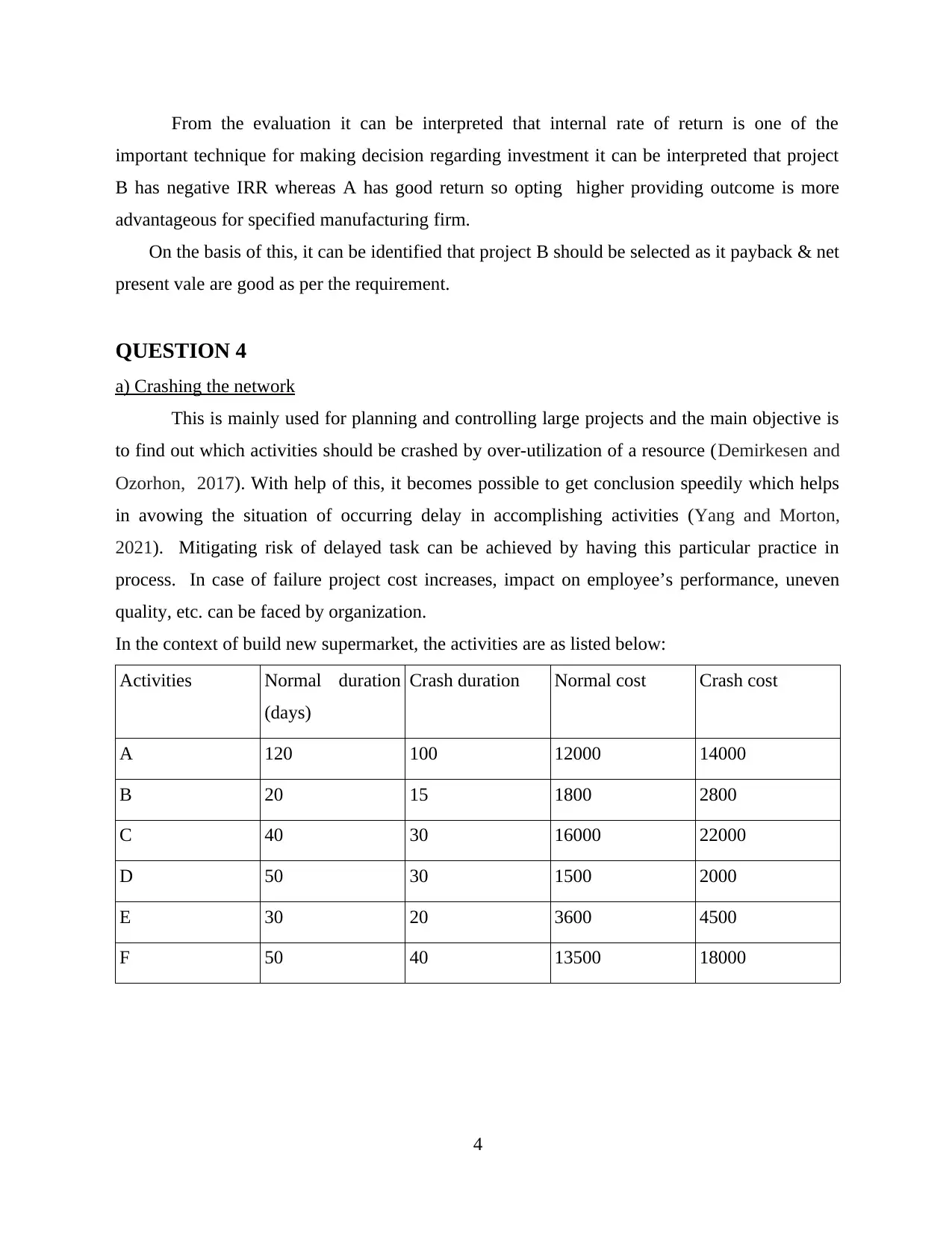
From the evaluation it can be interpreted that internal rate of return is one of the
important technique for making decision regarding investment it can be interpreted that project
B has negative IRR whereas A has good return so opting higher providing outcome is more
advantageous for specified manufacturing firm.
On the basis of this, it can be identified that project B should be selected as it payback & net
present vale are good as per the requirement.
QUESTION 4
a) Crashing the network
This is mainly used for planning and controlling large projects and the main objective is
to find out which activities should be crashed by over-utilization of a resource (Demirkesen and
Ozorhon, 2017). With help of this, it becomes possible to get conclusion speedily which helps
in avowing the situation of occurring delay in accomplishing activities (Yang and Morton,
2021). Mitigating risk of delayed task can be achieved by having this particular practice in
process. In case of failure project cost increases, impact on employee’s performance, uneven
quality, etc. can be faced by organization.
In the context of build new supermarket, the activities are as listed below:
Activities Normal duration
(days)
Crash duration Normal cost Crash cost
A 120 100 12000 14000
B 20 15 1800 2800
C 40 30 16000 22000
D 50 30 1500 2000
E 30 20 3600 4500
F 50 40 13500 18000
4
important technique for making decision regarding investment it can be interpreted that project
B has negative IRR whereas A has good return so opting higher providing outcome is more
advantageous for specified manufacturing firm.
On the basis of this, it can be identified that project B should be selected as it payback & net
present vale are good as per the requirement.
QUESTION 4
a) Crashing the network
This is mainly used for planning and controlling large projects and the main objective is
to find out which activities should be crashed by over-utilization of a resource (Demirkesen and
Ozorhon, 2017). With help of this, it becomes possible to get conclusion speedily which helps
in avowing the situation of occurring delay in accomplishing activities (Yang and Morton,
2021). Mitigating risk of delayed task can be achieved by having this particular practice in
process. In case of failure project cost increases, impact on employee’s performance, uneven
quality, etc. can be faced by organization.
In the context of build new supermarket, the activities are as listed below:
Activities Normal duration
(days)
Crash duration Normal cost Crash cost
A 120 100 12000 14000
B 20 15 1800 2800
C 40 30 16000 22000
D 50 30 1500 2000
E 30 20 3600 4500
F 50 40 13500 18000
4
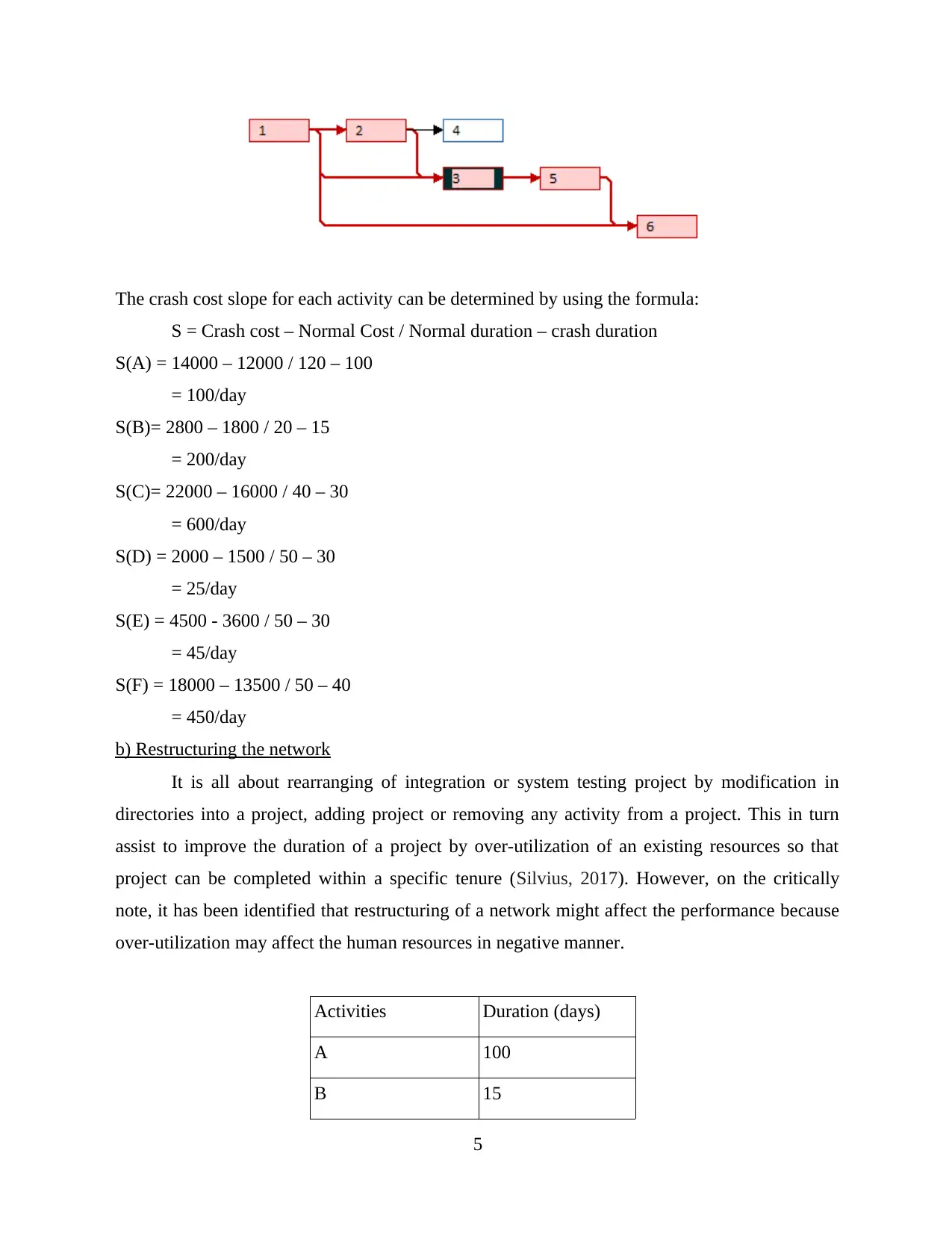
The crash cost slope for each activity can be determined by using the formula:
S = Crash cost – Normal Cost / Normal duration – crash duration
S(A) = 14000 – 12000 / 120 – 100
= 100/day
S(B)= 2800 – 1800 / 20 – 15
= 200/day
S(C)= 22000 – 16000 / 40 – 30
= 600/day
S(D) = 2000 – 1500 / 50 – 30
= 25/day
S(E) = 4500 - 3600 / 50 – 30
= 45/day
S(F) = 18000 – 13500 / 50 – 40
= 450/day
b) Restructuring the network
It is all about rearranging of integration or system testing project by modification in
directories into a project, adding project or removing any activity from a project. This in turn
assist to improve the duration of a project by over-utilization of an existing resources so that
project can be completed within a specific tenure (Silvius, 2017). However, on the critically
note, it has been identified that restructuring of a network might affect the performance because
over-utilization may affect the human resources in negative manner.
Activities Duration (days)
A 100
B 15
5
S = Crash cost – Normal Cost / Normal duration – crash duration
S(A) = 14000 – 12000 / 120 – 100
= 100/day
S(B)= 2800 – 1800 / 20 – 15
= 200/day
S(C)= 22000 – 16000 / 40 – 30
= 600/day
S(D) = 2000 – 1500 / 50 – 30
= 25/day
S(E) = 4500 - 3600 / 50 – 30
= 45/day
S(F) = 18000 – 13500 / 50 – 40
= 450/day
b) Restructuring the network
It is all about rearranging of integration or system testing project by modification in
directories into a project, adding project or removing any activity from a project. This in turn
assist to improve the duration of a project by over-utilization of an existing resources so that
project can be completed within a specific tenure (Silvius, 2017). However, on the critically
note, it has been identified that restructuring of a network might affect the performance because
over-utilization may affect the human resources in negative manner.
Activities Duration (days)
A 100
B 15
5
Paraphrase This Document
Need a fresh take? Get an instant paraphrase of this document with our AI Paraphraser
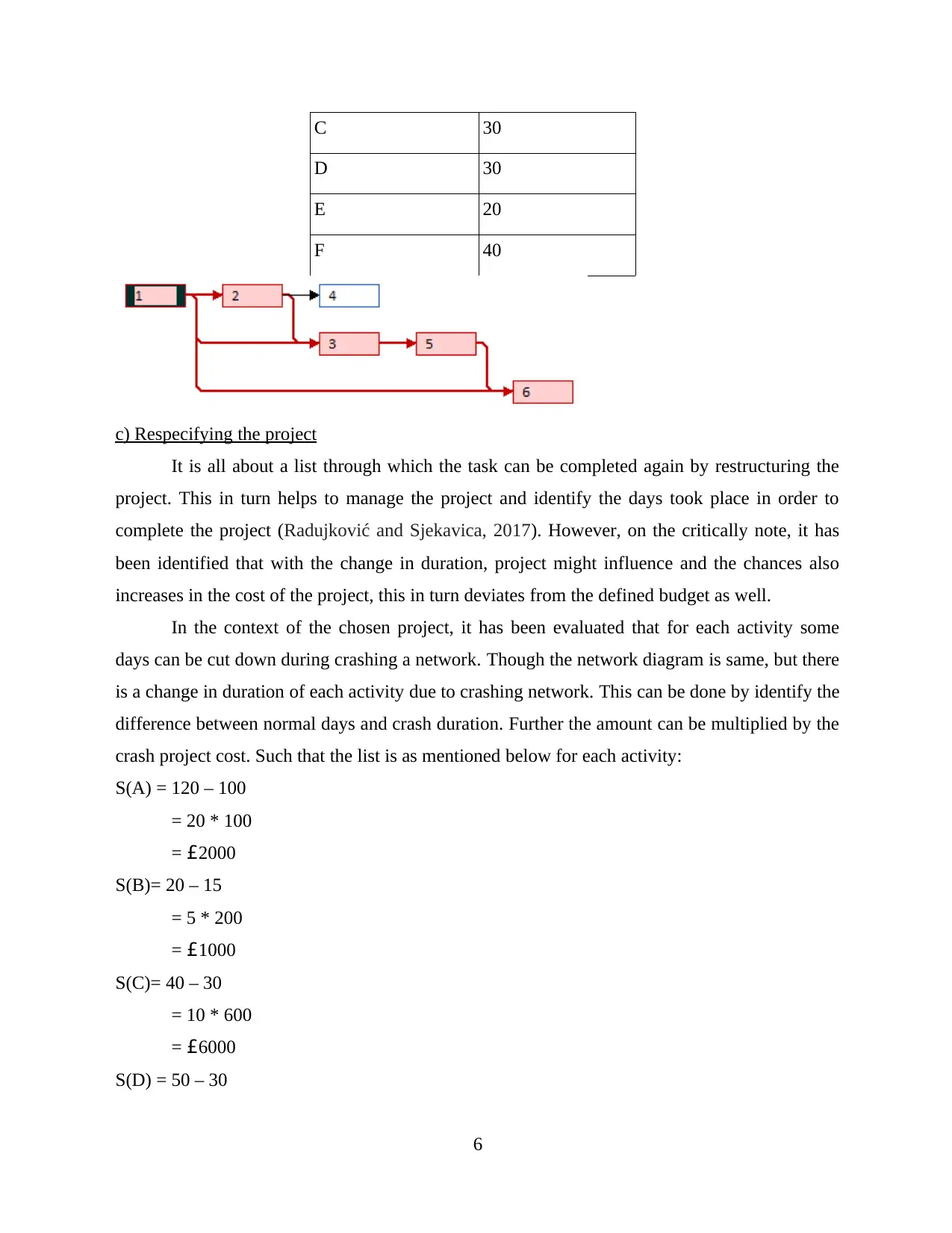
C 30
D 30
E 20
F 40
c) Respecifying the project
It is all about a list through which the task can be completed again by restructuring the
project. This in turn helps to manage the project and identify the days took place in order to
complete the project (Radujković and Sjekavica, 2017). However, on the critically note, it has
been identified that with the change in duration, project might influence and the chances also
increases in the cost of the project, this in turn deviates from the defined budget as well.
In the context of the chosen project, it has been evaluated that for each activity some
days can be cut down during crashing a network. Though the network diagram is same, but there
is a change in duration of each activity due to crashing network. This can be done by identify the
difference between normal days and crash duration. Further the amount can be multiplied by the
crash project cost. Such that the list is as mentioned below for each activity:
S(A) = 120 – 100
= 20 * 100
= £2000
S(B)= 20 – 15
= 5 * 200
= £1000
S(C)= 40 – 30
= 10 * 600
= £6000
S(D) = 50 – 30
6
D 30
E 20
F 40
c) Respecifying the project
It is all about a list through which the task can be completed again by restructuring the
project. This in turn helps to manage the project and identify the days took place in order to
complete the project (Radujković and Sjekavica, 2017). However, on the critically note, it has
been identified that with the change in duration, project might influence and the chances also
increases in the cost of the project, this in turn deviates from the defined budget as well.
In the context of the chosen project, it has been evaluated that for each activity some
days can be cut down during crashing a network. Though the network diagram is same, but there
is a change in duration of each activity due to crashing network. This can be done by identify the
difference between normal days and crash duration. Further the amount can be multiplied by the
crash project cost. Such that the list is as mentioned below for each activity:
S(A) = 120 – 100
= 20 * 100
= £2000
S(B)= 20 – 15
= 5 * 200
= £1000
S(C)= 40 – 30
= 10 * 600
= £6000
S(D) = 50 – 30
6

= 20 * 25
= £500
S(E) = 30 – 20
= 10 * 45
= £450
S(F) = 50 – 40
= 10 * 450
= £4500
Through the above it has been identified that with the help of crashing, restructuring and
re-specifying the project, project manager able to deliver the project on time.
7
= £500
S(E) = 30 – 20
= 10 * 45
= £450
S(F) = 50 – 40
= 10 * 450
= £4500
Through the above it has been identified that with the help of crashing, restructuring and
re-specifying the project, project manager able to deliver the project on time.
7
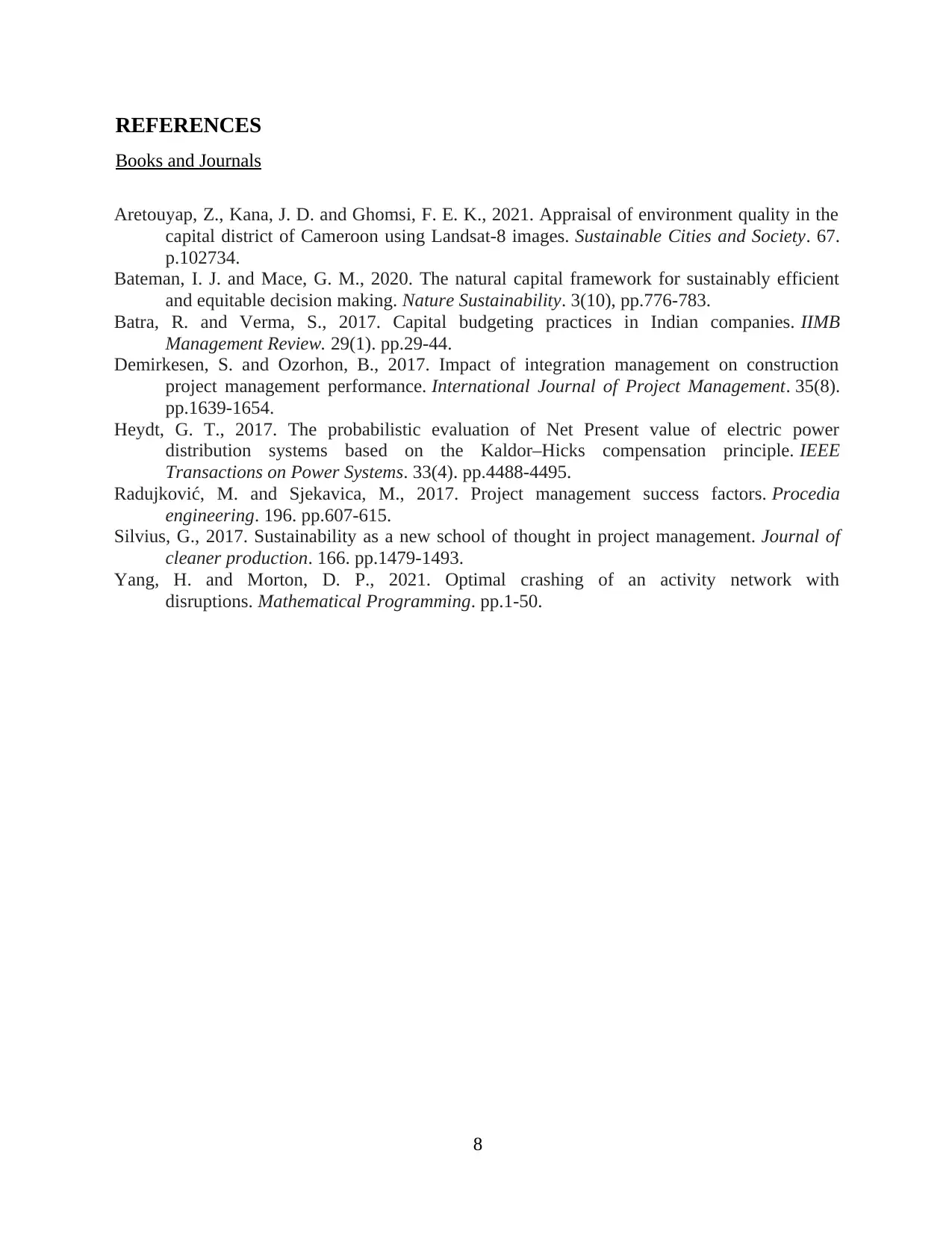
REFERENCES
Books and Journals
Aretouyap, Z., Kana, J. D. and Ghomsi, F. E. K., 2021. Appraisal of environment quality in the
capital district of Cameroon using Landsat-8 images. Sustainable Cities and Society. 67.
p.102734.
Bateman, I. J. and Mace, G. M., 2020. The natural capital framework for sustainably efficient
and equitable decision making. Nature Sustainability. 3(10), pp.776-783.
Batra, R. and Verma, S., 2017. Capital budgeting practices in Indian companies. IIMB
Management Review. 29(1). pp.29-44.
Demirkesen, S. and Ozorhon, B., 2017. Impact of integration management on construction
project management performance. International Journal of Project Management. 35(8).
pp.1639-1654.
Heydt, G. T., 2017. The probabilistic evaluation of Net Present value of electric power
distribution systems based on the Kaldor–Hicks compensation principle. IEEE
Transactions on Power Systems. 33(4). pp.4488-4495.
Radujković, M. and Sjekavica, M., 2017. Project management success factors. Procedia
engineering. 196. pp.607-615.
Silvius, G., 2017. Sustainability as a new school of thought in project management. Journal of
cleaner production. 166. pp.1479-1493.
Yang, H. and Morton, D. P., 2021. Optimal crashing of an activity network with
disruptions. Mathematical Programming. pp.1-50.
8
Books and Journals
Aretouyap, Z., Kana, J. D. and Ghomsi, F. E. K., 2021. Appraisal of environment quality in the
capital district of Cameroon using Landsat-8 images. Sustainable Cities and Society. 67.
p.102734.
Bateman, I. J. and Mace, G. M., 2020. The natural capital framework for sustainably efficient
and equitable decision making. Nature Sustainability. 3(10), pp.776-783.
Batra, R. and Verma, S., 2017. Capital budgeting practices in Indian companies. IIMB
Management Review. 29(1). pp.29-44.
Demirkesen, S. and Ozorhon, B., 2017. Impact of integration management on construction
project management performance. International Journal of Project Management. 35(8).
pp.1639-1654.
Heydt, G. T., 2017. The probabilistic evaluation of Net Present value of electric power
distribution systems based on the Kaldor–Hicks compensation principle. IEEE
Transactions on Power Systems. 33(4). pp.4488-4495.
Radujković, M. and Sjekavica, M., 2017. Project management success factors. Procedia
engineering. 196. pp.607-615.
Silvius, G., 2017. Sustainability as a new school of thought in project management. Journal of
cleaner production. 166. pp.1479-1493.
Yang, H. and Morton, D. P., 2021. Optimal crashing of an activity network with
disruptions. Mathematical Programming. pp.1-50.
8
1 out of 10
Related Documents
Your All-in-One AI-Powered Toolkit for Academic Success.
+13062052269
info@desklib.com
Available 24*7 on WhatsApp / Email
![[object Object]](/_next/static/media/star-bottom.7253800d.svg)
Unlock your academic potential
© 2024 | Zucol Services PVT LTD | All rights reserved.





